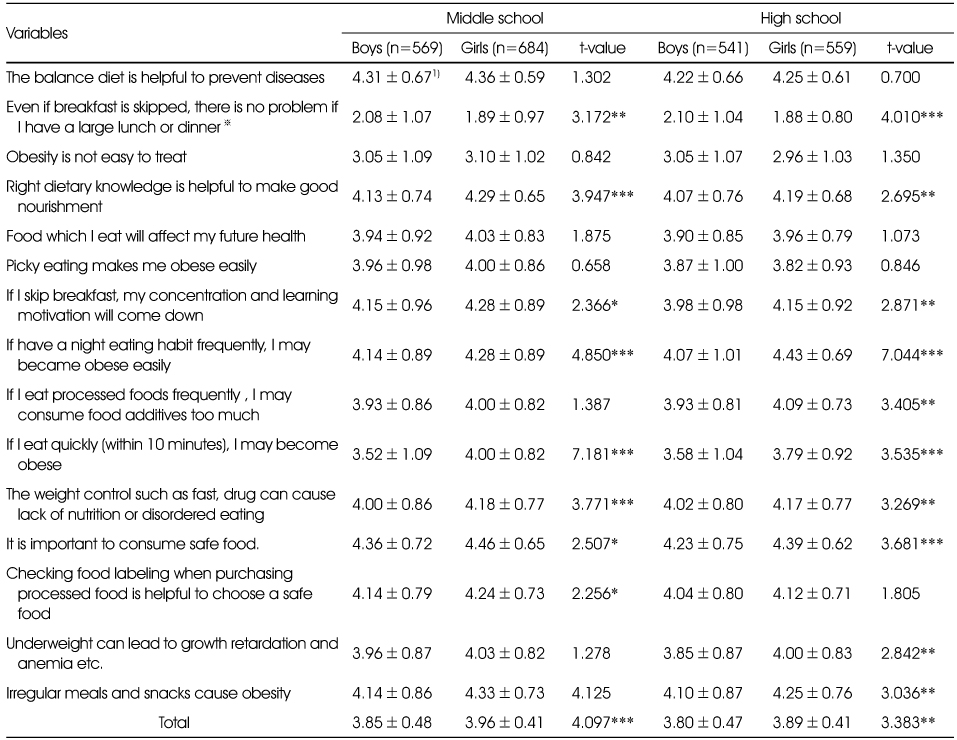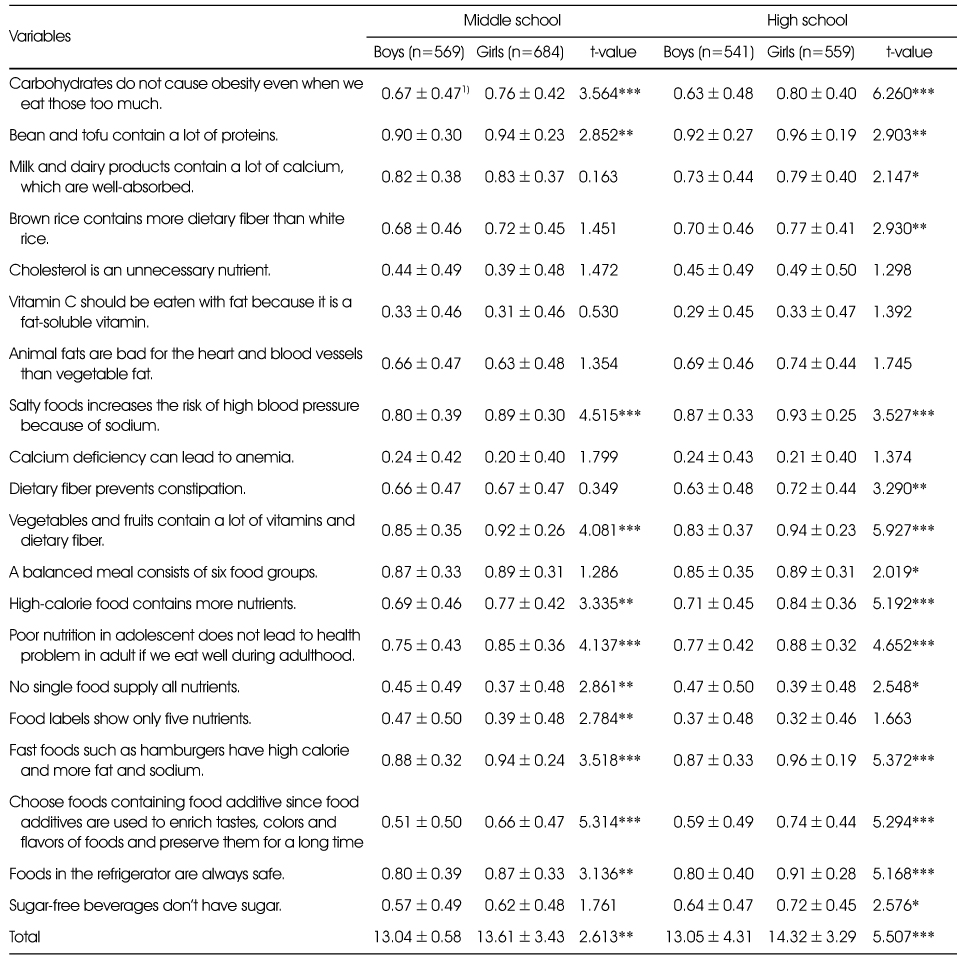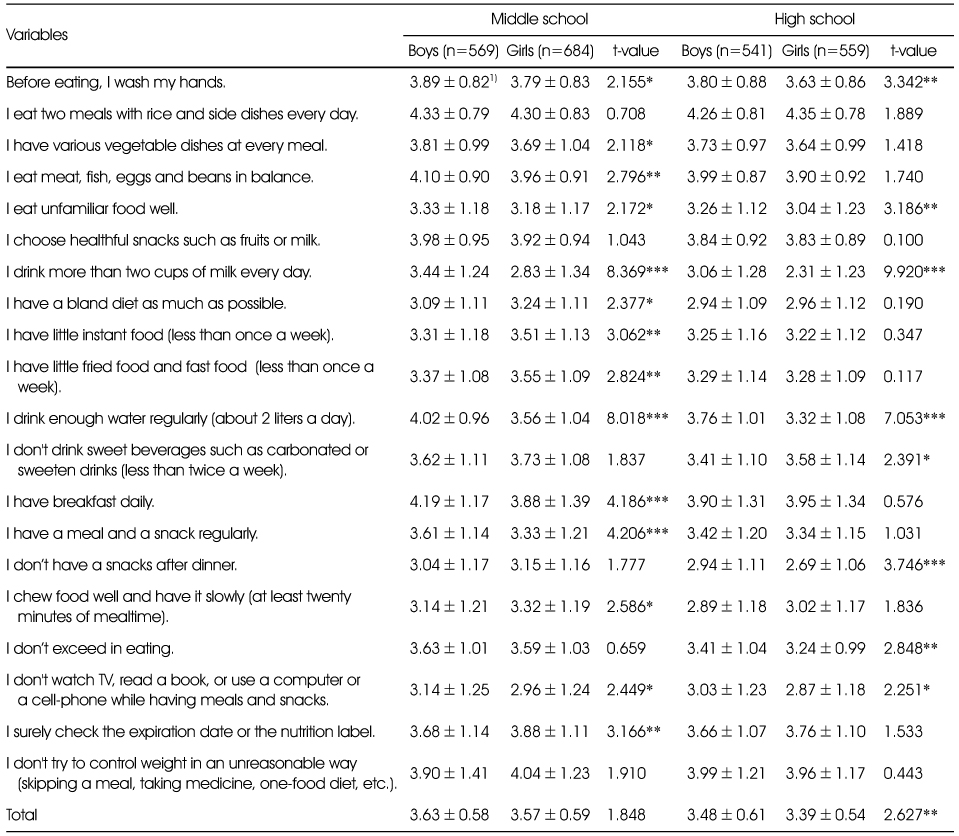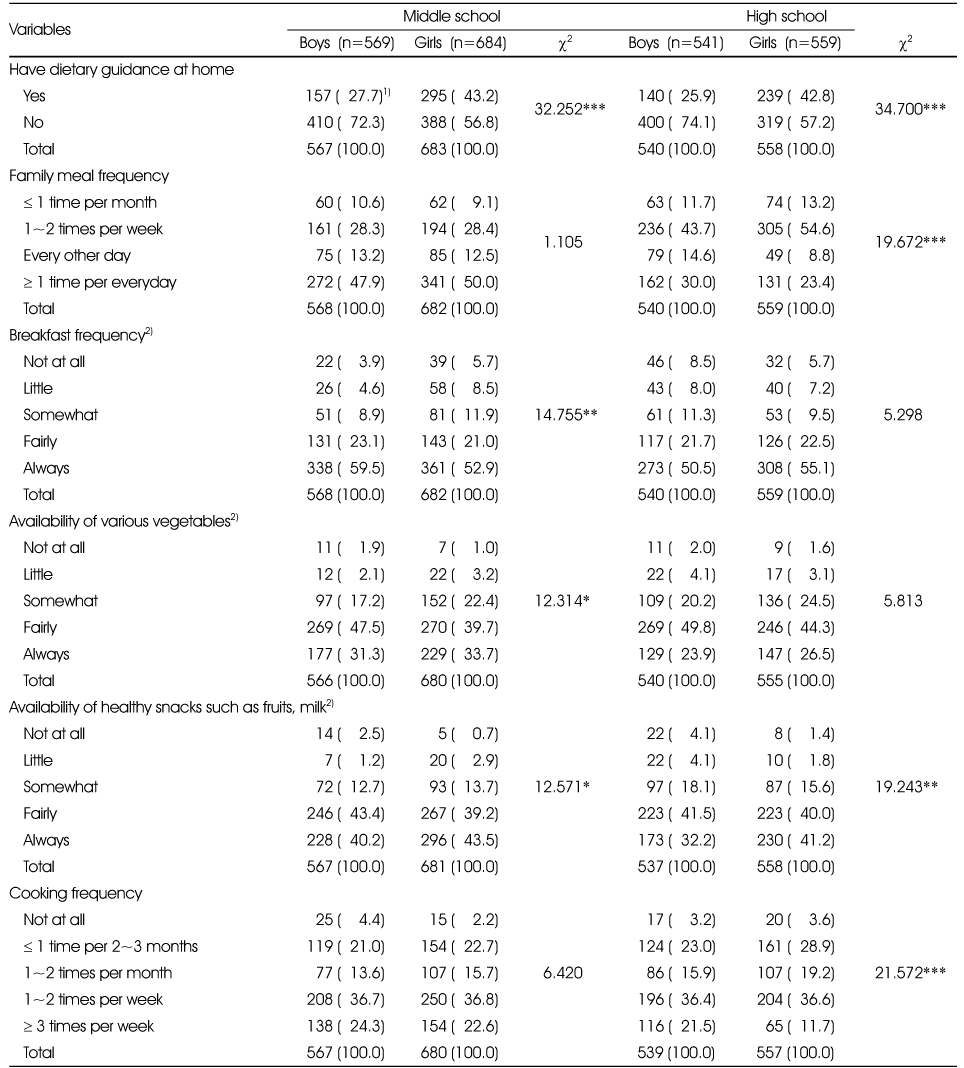Articles
- Page Path
- HOME > Korean J Community Nutr > Volume 21(2); 2016 > Article
-
Research Article
- Gender Differences in Adolescents' Dietary Perceptions and Practices
-
Taejung Woo, Hye-Jin Lee, Kyoung Ae Lee, Seung Min Lee, Kyung-Hea Lee

-
Korean Journal of Community Nutrition 2016;21(2):165-177.
DOI: https://doi.org/10.5720/kjcn.2016.21.2.165
Published online: April 30, 2016
1Department of Food and Nutrition, Changwon National University, Changwon, Korea.
2Department of Practical Arts Education and Centre for Child Nutrition Education, Busan National University of Education, Busan, Korea.
3Department of Food and Nutrition, Sungshin Woman's University, Seoul, Korea.
- Corresponding author: Kyung-Hea Lee. Department of Food and Nutrition, Changwon National University, 20 Changwondaehakro, Uichang-gu, Changwon, Gyeongnam, 51140, Korea. Tel: (055) 213-3514, Fax: (055) 281-7480, khl@changwon.ac.kr
Copyright © 2016 The Korean Society of Community Nutrition
This is an Open-Access article distributed under the terms of the Creative Commons Attribution Non-Commercial License (http://creativecommons.org/licenses/by-nc/3.0/) which permits unrestricted non-commercial use, distribution, and reproduction in any medium, provided the original work is properly cited.
- 1,583 Views
- 7 Download
- 9 Crossref
Figure & Data
REFERENCES
Citations

- Secular Trends in Dietary Patterns Among Korean Adolescents: Using Data From the 2007–2022 Korea National Health and Nutrition Examination Survey
Eunyoung Tak, Eugene Kang, Minji Kang
Clinical Nutrition Research.2025; 14(4): 270. CrossRef - Development of evaluation items for adolescents’ dietary habits and nutritional practices reflecting eating behaviors and food environment
Jimin Lim, Hye Ji Seo, Jieun Oh
Journal of Nutrition and Health.2024; 57(1): 136. CrossRef - Changes in Ultra-Processed Food Consumption among Adolescents before and after the COVID-19 Pandemic : Using Data from the 7th (2018~2019) and 8th (2020~2021) Korea National Health and Nutrition Examination Survey
Hyun-Jin Hwang, Yoo Kyeong Kim
Korean Journal of Human Ecology.2024; 33(6): 981. CrossRef - Restaurant Meal Delivery and Take-Out Consumption Behavior according to Adolescents’ Food-Related Lifestyles
Yulee Shin, Minsook Kyung, Seonyeong Baek, Sunny Ham
Journal of the East Asian Society of Dietary Life.2021; 31(3): 172. CrossRef - Association between Stress and Nutritional status of High School Students in Chungbuk using Nutrition Quotient for Korean Adolescents
In Young Kim, Mi-Kyeong Choi
Korean Journal of Community Nutrition.2020; 25(5): 361. CrossRef - Development of NQ-A, Nutrition Quotient for Korean Adolescents, to assess dietary quality and food behavior
Hye-Young Kim, Jung-Sug Lee, Ji-Yun Hwang, Sehyug Kwon, Hae Rang Chung, Tong-Kyung Kwak, Myung-Hee Kang, Young-Sun Choi
Journal of Nutrition and Health.2017; 50(2): 142. CrossRef - Nutrition Knowledge, Dietary Attitudes, and Dietary Behaviors by Gender of High School Students in Incheon
Zolzaya Erdenebileg, So Hyun Park, Su Ji Park, Kyung Ja Chang
Journal of The Korean Society of Food Culture.2016; 31(6): 652. CrossRef - Adulterated Food Management Characteristics according to Dietary Lifestyles among Adolescents
Yunhwa Kim
Korean Journal of Community Nutrition.2016; 21(6): 509. CrossRef - Application and the Effect of Nutrition Education Program Based on the Social Cognitive Theory Among Middle School Girls
Jihea Kim, Taejung Woo, Kyoung Ae Lee, Seung Min Lee, Kyung-Hea Lee
Korean Journal of Community Nutrition.2016; 21(6): 497. CrossRef
Comparison of interest in diet and health between the groups (n=2,353)
1) Mean±SD (5 likert scale: '1' never through '5' very much)
*: p<0.05, **: p<0.01, ***: p<0.001 by t-test
Comparison of perception on dietary education between the school groups (n=2,353)
1) N (%)
2) Multiple response
*: p<0.05, **: p<0.01, ***: p<0.001 by χ2-test
Comparison of dietary perception between the groups (n=2,353)
※: The item was scored inversely
1) Mean±SD (5 likert scale: '1' strongly disagree through '5' strongly agree)
*: P<0.05, **: P<0.01, ***: P<0.001 by t-test
Comparison of nutrition knowledge between the groups (n=2,353)
1) Mean±SD (Total score: 15, 1-right, 0-wrong), *: P<0.05, **: P<0.01, ***: P<0.001 by t-test
Comparison of dietary practices between the groups (n=2,353)
1) Mean±SD(5 likert scale: '1' strongly disagree through '5' strongly agree), *: P<0.05, **: P<0.01, ***: P<0.001 by t-test
Comparison of dietary environment at home between the groups (n=2,353)
1) N (%)
2) The variables were regrouped together as dietary environment at home in regression analysis. Each item was scored using 5 likert scale ('1' not at all through '5' always).
*: P<0.05, **: P<0.01, ***: P<0.001 by χ2-test
Regression analysis between dietary practices and related variables (n=2,353)
Dependent variable: dietary Practice
1) Environment (breakfast frequency, availability of vegetables, availability of fruits and milk)
1) Mean±SD (5 likert scale: '1' never through '5' very much) *: p<0.05, **: p<0.01, ***: p<0.001 by t-test
1) N (%) 2) Multiple response *: p<0.05, **: p<0.01, ***: p<0.001 by χ2-test
※: The item was scored inversely 1) Mean±SD (5 likert scale: '1' strongly disagree through '5' strongly agree) *: P<0.05, **: P<0.01, ***: P<0.001 by t-test
1) Mean±SD (Total score: 15, 1-right, 0-wrong), *: P<0.05, **: P<0.01, ***: P<0.001 by t-test
1) Mean±SD(5 likert scale: '1' strongly disagree through '5' strongly agree), *: P<0.05, **: P<0.01, ***: P<0.001 by t-test
1) N (%) 2) The variables were regrouped together as dietary environment at home in regression analysis. Each item was scored using 5 likert scale ('1' not at all through '5' always). *: P<0.05, **: P<0.01, ***: P<0.001 by χ2-test
Dependent variable: dietary Practice 1) Environment (breakfast frequency, availability of vegetables, availability of fruits and milk)

 KSCN
KSCN







 Cite
Cite


